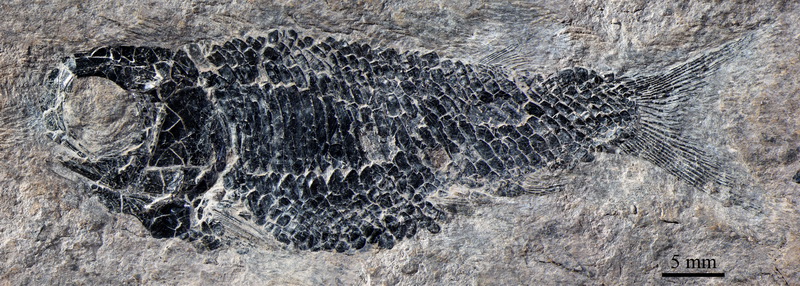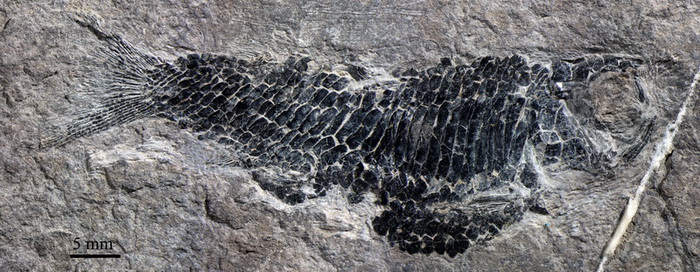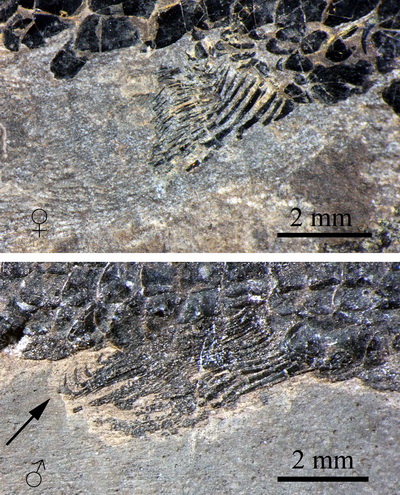|
||||||||||||
| 购买进口仪器、试剂和耗材——就在始于2001年的毕特博生物 www.bitebo.com |
中国科学院古脊椎动物与古人类研究所和浙江自然博物馆组成的研究小组在贵州省发现一种距今约2亿4千万年的史前飞鱼类化石:精美乌沙鱼(Wushaichthys exquisitus)。该发现代表了飞鱼类最原始最古老的化石记录,为研究史前飞鱼的生殖方式和水上滑翔起源提供了新的证据。同时,这项发现也增进了人们对中三叠世时期古特提斯洋生态复杂性的认识,对二叠纪末生物大灭绝后的古生态系统变化研究有非常重要的意义。最新一期的英国皇家学会《生物学报》(BioLogy Letters)刊发了徐光辉和他的同事赵丽君和沈辰辰的该项研究成果,引起了国内外多家媒体纷纷报道。 “海阔凭鱼跃,天高任鸟飞”。在浩瀚无垠的海洋中,有一种闻名遐迩的飞鱼。它们破浪而出,犹如群鸟一般掠过海空,堪称一大自然奇观。在动物王国中,会飞的脊椎动物不少,但在长达4亿多年的硬骨鱼类进化历史中,水上滑翔机制只出现过两次,分别出现在2亿多年前的胸鳍鱼科(Thoracopteridae)和现代的飞鱼科(Exocoetidae)。除了一对异常宽大的胸鳍作为“主翼”和一对较大的腹鳍作为“辅翼”外,飞鱼类还进化出一个深分叉且非对称的尾鳍(尾下叶明显比尾上叶强壮);这种尾鳍的快速摆动可以产生强大的推力帮助它们跃出水面并借助宽大的胸鳍在空中滑翔。因为现代飞鱼类化石稀少,人们尚不清楚飞鱼类如何形成这种水上滑翔能力,但是灭绝的飞鱼物种化石或许能够让科学家了解这些飞鱼类生物是如何进化出滑翔能力的。根据精美乌沙鱼以及其它史前飞鱼化石的研究,徐光辉等提出了一个“头部特化-尾下叶加长-胸鳍变大-鳞片退化”的史前飞鱼演化序列,认为飞鱼类的水上滑翔是逐步进化而成的:首先它们头部特化可能帮助它们生活于上层水域,然后进化出非对称尾鳍以帮助它们从水中弹射出来,再然后进化出帮助它们在空中滑翔的大胸鳍,最终鳞片退化使得它们体重减轻以增进滑翔的效能和机动性。 脊椎动物的受精方式可分体外受精和体内受精。大部分的现代鱼类均为体外受精,但是鲨鱼、空棘鱼和少量的真骨鱼是行体内受精。这些体内受精的鱼类进化出特化的生殖器鳍脚将精子送入雌性体内。为了适应海洋表层水域生活和繁殖,现代飞鱼的产卵习性很特别,它们生下来的卵需要附着在海面的飘浮物上,例如马尾藻的下面,甚至于连飘浮的竹竿或杂物它们也可以利用。对精美乌沙鱼和其它史前飞鱼化石的研究,徐光辉等认为史前飞鱼的生殖方式与现代飞鱼不同,是体内受精的。也就是说,史前飞鱼类生下来就是小鱼,就像人类、鲸鱼和卵胎生真骨鱼类似。保存十分完好的史前飞鱼化石显示雄性个体的臀鳍条十分特化,其末端带有一序列的钩子。据此推测,史前飞鱼的交配过程与现代卵胎生真骨鱼类似,雄鱼的臀鳍在肌肉的帮助下勃起,向前伸到雌鱼的身体下方泄殖腔内,雄鱼用臀鳍条末端的钩子抓住雌鱼,以帮助顺利完成体内受精过程。 该项研究获得了国家自然科学基金委员会、现代古生物学和地层学国家重点实验室(中科院南京地质古生物研究所)和中科院古生物化石发掘与修理专项经费的资助。  图1:精美乌沙鱼的雄性个体(徐光辉供图)  图2:精美乌沙鱼的雌性个体(徐光辉供图)  图3:精美乌沙鱼的雌雄和雄性臀鳍对比, 箭头指示雄性臀鳍上的钩子(徐光辉供图) 原文链接:A Middle Triassic thoracopterid from China highlights the evolutionary origin of overwater gliding in early ray-finned fishes Gliding adaptations in thoracopterid flying fishes represent a remarkable case of convergent evolution of overwater gliding strategy with modern exocoetid flying fishes, but the evolutionary origin of this strategy was poorly known in the thoracopterids because of lack of transitional forms. Until recently, all thoracopterids, from the Late Triassic of Austria and Italy and the Middle Triassic of South China, were highly specialized ‘four-winged’ gliders in having wing-like paired fins and an asymmetrical caudal fin with the lower caudal lobe notably larger than the upper lobe. Here, we show that the new genus Wushaichthys and the previously alleged ‘peltopleurid’Peripeltopleurus, from the Middle Triassic (Ladinian, 235–242 Ma) of South China and near the Ladinian/Anisian boundary of southern Switzerland and northern Italy, respectively, represent the most primitive and oldest known thoracopterids. Wushaichthys, the most basal thoracopterid, shows certain derived features of this group in the skull. Peripeltopleurus shows a condition intermediate between Wushaichthys and Thoracopterus in having a slightly asymmetrical caudal fin but still lacking wing-like paired fins. Phylogenetic studies suggest that the evolution of overwater gliding of thoracopterids was gradual in nature; a four-stage adaption following the ‘cranial specialization–asymmetrical caudal fin–enlarged paired fins–scale reduction’ sequence has been recognized in thoracopterid evolution. Moreover, Wushaichthysand Peripeltopleurus bear hooklets on the anal fin of supposed males, resembling those of modern viviparious teleosts. Early thoracopterids probably had evolved a live-bearing reproductive strategy.
最专业有效的细胞离心涂片系统 Tharmac® Cellspin 载玻片离心机 (点击标题进入) 细胞治疗所使用的无血清培养基 lonza 04-418Q 无血清培养基 (点击标题进入) 干细胞治疗所使用的无血清培养基lonza 12-725F 无血清培养基 (点击标题进入) |
购买进口仪器、试剂和耗材——就在始于2001年的毕特博生物
www.bitebo.com |
|